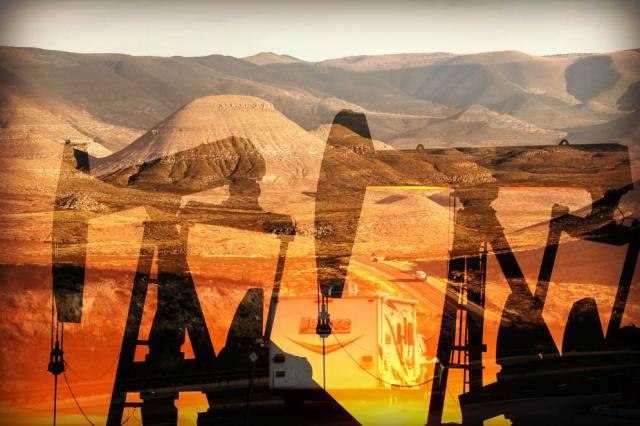
Despite recently being overshadowed by the neighboring San Juan, the Albuquerque Basin is expected to have resource potential in line with higher profile basins such as the Eagle Ford and Bakken shales. (Source: Hart Energy)
[Editor's note: A version of this story appears in the September 2018 edition of Oil and Gas Investor. Subscribe to the magazine here.]
The data room is open on a 142,000-acre prospect in the last emerging shale basin in the U.S.
The play, targeting Mancos Shale Gallup stratigraphy, is located near the junction of Bernalillo and Sandoval counties in New Mexico and promises 800 million barrels (MMbbl) of oil and 5 trillion cubic feet of natural gas recoverable across a 450,000-acre area.
Roswell, N.M.-based Thrust Energy Inc. is seeking an operating partner to develop the peak oil sweet spot northwest of Albuquerque and is providing access to 1.7 gigabytes of surface data, legacy well control, geochemistry, petrophysics, gravity data, title work and economics, including analog studies in the neighboring San Juan Basin oil play.
Thrust Energy CEO James Manatt, Jr. assembled a technical team in 2013 that included alumni of Royal Dutch Shell Plc (NYSE: RDS.A) who had worked the Albuquerque Basin from 1970 to 1982. Thrust specializes in finding stranded oil behind pipe and essentially pulled together Shell’s corporate “memory,” seismic data and developing well control within the peak oil window from 12 legacy vertical pilot wells.
The Albuquerque play is an extension of the San Juan Basin oil play and features at least three stacked petroleum systems. Unconventional and hybrid conventional targets reside in Mancos/Gallup stratigraphy in the lower 500 feet of a 1,500-foot Cretaceous column, which can be exploited, as Encana Corp. (NYSE: ECA) and WPX Energy Inc. (NYSE: WPX) have demonstrated, with horizontal drilling and modern multistage stimulation methodology.
The San Juan portion of the play features well costs below $4.5 million, IPs exceeding 1,000 barrels of oil equivalent per day (boe/d) and EURs of 750,000 boe on six-well spacing targeting various landing zones within a section and one half. Potential yield is upward of 6 MMbbl per section, placing Albuquerque potential in line with higher profile basins such as the Eagle Ford and Bakken shales.
The 12 vertical pilot wells drilled from 1970 through 1995 establish reservoir geochemistry and thermal maturity but lacked the lateral completion technology to be economic in that earlier era. At today’s oil prices, Gallup wells provide internal rates of return above 90% with payouts of one year or less for the best prospects.
The Albuquerque Basin has been overshadowed by the neighboring San Juan, which has a 50-year history as the nation’s largest conventional gas play. The San Juan has seen a recurring cycle of larger multinationals exiting for pennies on the dollar during tough times with regional players buying in, followed by the return of larger firms in better times.
Recent examples include Hilcorp Energy Co.’s $2.7 billion purchase of ConocoPhillips Co.’s (NYSE: COP) San Juan assets in 2017 and WPX’s $700 million sale of 100,000 acres and 150 producing wells earlier this year to Enduring Resources IV LLC.
The San Juan Basin produced cumulative oil and NGL of 40 MMboe plus 68 Bcf of natural gas as of year-end 2017. Encana and WPX had been the major players in the San Juan oil play targeting the Mancos and Gallup shales. Encana is planning a six-well Mancos program in second-half 2018.
During early Cretaceous time, all Rocky Mountain basins were part of a geologic system involving a large inland sea and a contiguous shoreline that stretched southeast across the San Juan into the Albuquerque Basin. Tectonics associated with the Laramide uplift divided those basins into the Denver-Julesburg (D-J), the Piceance, the Uinta, the San Juan, the Albuquerque and others, with the Albuquerque bounded by the Sandia Mountains to the east and the Jemez lineament to the northwest
While the D-J Basin yields hydrocarbons from deeper basinal stratigraphy, the San Juan and Albuquerque Basins are closer to the original paleo shore. The sweet spot in the Thrust package is roughly 40 miles southeast of WPX acreage on trend.
Multiple drilling fairways exist in a peak oil window up to 12 miles wide across a 30- to 60-mile area with normal to overpressured reservoir conditions in naturally fractured stratigraphy up to 70 feet thick, twice that of the prolific but underpressured oil-bearing San Juan Mancos.
Albuquerque Basin production has access to refineries in Gallup, N.M., or, via two rail lines, to U.S. refinery complexes outside the Permian Basin. A regional natural gas pipeline connects the basin to major east-west pipelines carrying gas to the West Coast.
The play fills in the last gap in a contiguous shale basin lineament arcing southeast from the Rockies, curving north in Texas, and continuing into Appalachia.
Richard Mason can be reached at rmason@hartenergy.com.
Recommended Reading
Defeating the ‘Four Horsemen’ of Flow Assurance
2024-04-18 - Service companies combine processes and techniques to mitigate the impact of paraffin, asphaltenes, hydrates and scale on production—and keep the cash flowing.
Tech Trends: AI Increasing Data Center Demand for Energy
2024-04-16 - In this month’s Tech Trends, new technologies equipped with artificial intelligence take the forefront, as they assist with safety and seismic fault detection. Also, independent contractor Stena Drilling begins upgrades for their Evolution drillship.
AVEVA: Immersive Tech, Augmented Reality and What’s New in the Cloud
2024-04-15 - Rob McGreevy, AVEVA’s chief product officer, talks about technology advancements that give employees on the job training without any of the risks.
Lift-off: How AI is Boosting Field and Employee Productivity
2024-04-12 - From data extraction to well optimization, the oil and gas industry embraces AI.
AI Poised to Break Out of its Oilfield Niche
2024-04-11 - At the AI in Oil & Gas Conference in Houston, experts talked up the benefits artificial intelligence can provide to the downstream, midstream and upstream sectors, while assuring the audience humans will still run the show.





